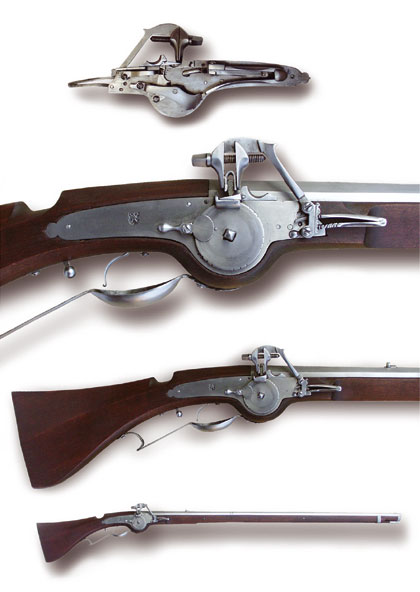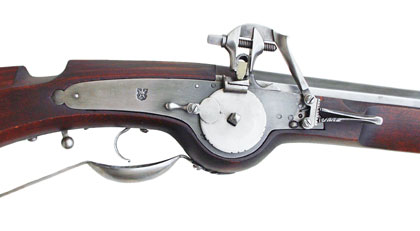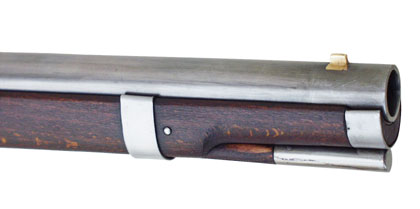Wheellock Musket, Suhl before 1634
 Replica of a wheellock musket built according to an original from the magazine of the firearm museum Suhl . Original prduced in Suhl, between 1630 and 1634 Replica of a wheellock musket built according to an original from the magazine of the firearm museum Suhl . Original prduced in Suhl, between 1630 and 1634
Total length:
155 cm
Barrel length: 115 cm
Calibre (Bore): 18 mm
Weight: 5100 gramms
Octagonal barrel with dovetail slided in front and rear sight, transitioning via 6 half-radially cannelures into a round cross section after the first third. Brown stained and oiled beech stock with one ramrod band and nose cap. Wooden ramrod with copper soldered metal top and inside thread for fixing a cleaning jag or worm. Wheellock with trible screwed lock plate. The original manufakturing and proof marks replaced by Armin Koenig's master mark. Safety slide behind the drigger. Spoonshaped drigger guard.
Matchlock muskets, despite of their reliability and comparable low price, had a significant disadvantage. They required a smouldering slow match, which made handling of this type of firearms complicated and sometimes dangerous. In suddenly arising combat situations, lighting of the match caused delays and also was easily to be seen in dark surroundings. Also the quatities of slow match continuously needed to suply the muesketeers was significant. This disadvantages caused army officials and gunmakers to think about alternatives. One possibility was, to equip muskets with wheellocks. This mechanism did not require smouldering matches and was immediately ready to fire. Disadvantages were the relatively high prices and the complexity of the wheellock mechanism, which was somewhat liable for malfactions. Wheellock muskets therefore normally where issued to a small part of the company or regiment only. In most cases they were used in special forces, for examply for companies on guard or for artillery trains, where open fire was forbidden. Their main use however was within dragoon units, as handling of the slow match on horseback was rather complicated and wheellocks, or "firelocks", as they were called then, brought significant advantages to those forces.

The spoon-shaped trigger guard seen on this musket detail, gives a strong indication, that this type of firearm mostly was used within cavallery units, preferably by dragoons. The musket was carried across the back by using a leather strap, which was simply attached by slings around the forestock and the butt (not using sling swivels). The spoonshaped guard prevented the trigger from being cought up and damaged by parts of the clothing or equipment (the same shape of the trigger guard can be seen with short wheellock carbines, the firearms of arquebusiers, which however were attached to a bandolier by using a spring-hook). The sliding handle behind the trigger serves as a safety mechanism, which in case of a spanned lock blocks the sear-lever from inside. (For detailed explanations of the wheellock mechanics see the wheellock function page).

An inside view of the lock shows no technical extravaganzas (as with most military firearms), but conspicuously precise manufacturing and fitting chracteristics. Clearly to be seen is the the main sear lever engaging through a hole of the lockplate into a recess at the inner side of the wheel and thus retaining it in spanned position. Differently to most Suhl-manufactured pistols, that only use 2 mounting screws, this musket lockplate is attached to the stock by using 3 screws.

Detail of the muzzle section shows the dovetail bead made of brass. The forestock is terminated by support of a metal nose-band, and the the metal -tipped ramrod is held in position by only one band as well. The smooth bore of the barrel is 18 mm, which corresponded to 15 bullets to a Nurnberg pound (510 gramms) or 13 bullets to an anglo-saxon pound, fired a rolling bullet of 16 to the pound of about 17-17,4 mm diameter, in Germany often called "2-löthige Kugel" (2 Loth=1 Nurnberg Unze = 31,7 gramms). Recognizable are the precise front and rear sights of this firearm. Shooting tests have proofen, that high quality Suhl match- and wheellock muskets, by using a good fitting non patched ball, can achieve good to excellent shooting results. The widespread oppinion, that 17th century muskets only hit targets when firing in huge bulks, surely does not apply to special firearms of this kind.
Back to Firearms
|
|